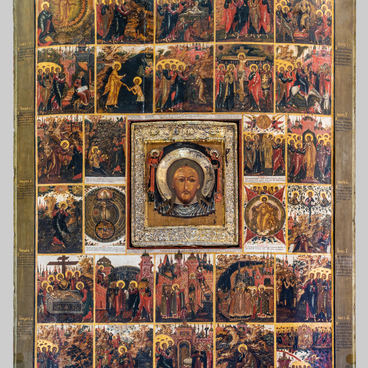The icon of the Annunciation was created by an unknown artist in the first half of the 15th century. It depicts one of the most popular scenes in visual arts. The icon shows the Archangel Gabriel telling the Virgin Mary the good news that she would become the mother of Jesus. The oldest images of the Annunciation were discovered in the Roman catacombs.
The canonical gospels do not say much about the Annunciation, so the iconography scheme developed thanks to the apocryphal Infancy Gospel of James, which says, ‘She took up the purple and sat upon her throne and spun the purple… And look! An angel of the Lord stood before her, saying, “Don”t fear, Mary, because you”ve found grace before the Lord of All. You”ll conceive from God”s word.”
The author based his work on that description. On the left, he depicted the Archangel Gabriel, and on the right, a seated Virgin Mary with a vermilion yarn. She is holding the thread from a spindle that has fallen down in the open palm of her right hand. Her left hand, in which we see a skein of red woolen yarn, rests on her lap. The saint is humbly bowing her head.
The artist painted the Archangel with a big head and wide face, a massive wide neck, and large eyes. The saint is looking at Mary’s womb. He is extending his arm towards the woman, folding his fingers in a gesture that symbolises good news.
The figure of the Virgin Mary is slightly elongated. The artist has especially extended Mary’s neck and the upper part of her head under the omophorion — a technique characteristic of the 15th century Rostov icons (omophorion is a woman’s clothing in the form of a long robe that envelopes a woman from head to toe; icon painters always depict the Virgin Mary in this vestment).
Researchers say that the icon’s artistic structure bears many similarities to the Rostov-Suzdal icon painting tradition of the 15th century. The icons painted in that style were distinguished by delicate light colors; the artists used transparent and uneven layers of paint, a shining-through gesso, and visible strokes.
The icon of the Annunciation is painted in light colors. It’s structure is based on the layout of large spots of blue, green, red, brown, and ocher, but they are all weakened: the red color is muted, the blue is turning grey-blue, and the paints themselves are so transparent you can see the gesso shine through. The gesso is the white ground used in icons.
The architectural elements are depicted in a highly simplified and token manner. The entire background is occupied by a light green wall, along the edges of which we can see two towers with rounded roofs, The artist painted the outer walls of the towers pink, showing them in a reverse perspective. Between the towers there is an inscription in large vermilion letters. The wall is decorated with horizontal belts, with an ornament of slanting lines above them. The background above the wall is yellow-golden in color, extending to the sides of the icon.
The canonical gospels do not say much about the Annunciation, so the iconography scheme developed thanks to the apocryphal Infancy Gospel of James, which says, ‘She took up the purple and sat upon her throne and spun the purple… And look! An angel of the Lord stood before her, saying, “Don”t fear, Mary, because you”ve found grace before the Lord of All. You”ll conceive from God”s word.”
The author based his work on that description. On the left, he depicted the Archangel Gabriel, and on the right, a seated Virgin Mary with a vermilion yarn. She is holding the thread from a spindle that has fallen down in the open palm of her right hand. Her left hand, in which we see a skein of red woolen yarn, rests on her lap. The saint is humbly bowing her head.
The artist painted the Archangel with a big head and wide face, a massive wide neck, and large eyes. The saint is looking at Mary’s womb. He is extending his arm towards the woman, folding his fingers in a gesture that symbolises good news.
The figure of the Virgin Mary is slightly elongated. The artist has especially extended Mary’s neck and the upper part of her head under the omophorion — a technique characteristic of the 15th century Rostov icons (omophorion is a woman’s clothing in the form of a long robe that envelopes a woman from head to toe; icon painters always depict the Virgin Mary in this vestment).
Researchers say that the icon’s artistic structure bears many similarities to the Rostov-Suzdal icon painting tradition of the 15th century. The icons painted in that style were distinguished by delicate light colors; the artists used transparent and uneven layers of paint, a shining-through gesso, and visible strokes.
The icon of the Annunciation is painted in light colors. It’s structure is based on the layout of large spots of blue, green, red, brown, and ocher, but they are all weakened: the red color is muted, the blue is turning grey-blue, and the paints themselves are so transparent you can see the gesso shine through. The gesso is the white ground used in icons.
The architectural elements are depicted in a highly simplified and token manner. The entire background is occupied by a light green wall, along the edges of which we can see two towers with rounded roofs, The artist painted the outer walls of the towers pink, showing them in a reverse perspective. Between the towers there is an inscription in large vermilion letters. The wall is decorated with horizontal belts, with an ornament of slanting lines above them. The background above the wall is yellow-golden in color, extending to the sides of the icon.



